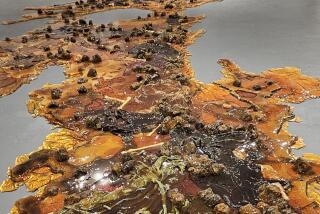Temporary Artwalk Projects Give City a Glimpse of What Public Artworks Could Do for Landscape
- Share via
ArtWalk can mean much more than a mass of people trekking downtown Saturday and Sunday to see art galleries, artists’ studios, performances and the few sites where permanent artworks have snuck through San Diego’s nationally renowned armor-against-art. It’s a chance, and a challenge, to consider what the visual arts really have to offer a city.
Four temporary projects in the Gaslamp Quarter and nearby areas lend themselves very well to such consideration. Each bears implications for what things might be like if artists and what they do were more a part of daily life here. None are in an art gallery. All were produced through Installation Gallery, the organizers of ArtWalk.
The most unusual of the four is Mario Lara’s “Home,” a sculpture perched on the roof of the Arts Complex, at 9th Avenue and G Street. Here, Lara has created another of those structures which are a hallmark of his art: a physical mid-point between architecture, with its functional orientation, and sculpture, which generally performs no other task than being itself.
This newest creation incorporates text and, for the first time, a silhouette of a human figure. The overall structure re-creates a cage. Inside is a mock TV with a picture of the Statue of Liberty painted on it. The cage suggests a house--at least a kind of house, like a large cardboard crate or the entryway of a building that can be a house if that’s all you have to call “home.”
Lara’s work doesn’t shout from the rooftop, it’s just there, like the homeless people are just there, downtown. It’s not a pleasant reality to confront, but the more it’s ignored the longer it persists, as is true of any problem. Art can’t solve the problem of homelessness, but it can present issues in fresh terms that can help keep concern alive. Any community that has any concerns can be served by art in precisely this way.
Concerns at once more personal, more universal and more delightful bounce forth from the series of window installations created by Leslie Nemour for the 4th Avenue facade of the Balboa Theatre, between E and F streets. A sweet and wild jumble of brightly colored images--fruits, insects, sections of road, tools, animals and people--inject a jolt of visual jazz into this otherwise bland urban environment.
Nemour’s inspiration comes from her young son, as she attempts to capture what it must be like for him to experience the deluge of new and unexplained images he encounters every day. Such childlike innocence and excitement successfully infects Nemour’s work which, in turn, infects its immediate environment with a very wonderful vitality. Who wouldn’t welcome this kind of influence in their community?
More along the lines of what a painting does for a wall in a home or office is Todd Stands’ and Susan Yamagata’s billboard, at the corner of 6th Avenue and G Street. The image, titled “Big Nature,” combines a blockish office building and a succulent of some sort in a brooding, drawing-like image suffused with an atmosphere of dark smog.
The artists presumably intend to put forth a warning here. But more significantly, the image stands as a kind of foil to the commercial intent of other billboards. Notwithstanding the popularity of advertising posters for home decor, who wants ads on their walls? So why not ask that at least a little art be mixed in with the commercial billboards that constitute one of the principal types of “decoration” downtown?
When it comes to billboards, there’s a middle ground here, too-- where art steps out beyond its formal concerns to engage the world around it, as does Lara’s “Home.” Billboards, with their juxtapositions of imagery and text, naturally attract artists with this orientation. David Avalos, Elizabeth Sisco, Louis Hock and Deborah Small are four artists with strong interests of this type.
Together they created a billboard at 11th Avenue and G Street that poses a very tough question juxtaposed against a salient image. The image shows Dr. Martin Luther King Jr. in mid-oratory, with his hand in a fist. The question posed takes the form of a fill-in-the-blank: Welcome to America’s Finest a) city, b) tourist plantation, c) convention center.
If this makes you think about recent events and controversies, then the artists have succeeded in their intent to make people more aware of their environment, the social environment in this case.
Each is part of art’s continuous fabric, reflecting aspects of what life is and what goes on in life. To deny art a place, to squeeze it into a corner, or to dictate that disengaged, pretty art is OK but engaged political art isn’t OK, is to deny a place for life itself, because the two parallel and reflect each other.
If this notion of reverberation between life and art informs people’s experience of ArtWalk, the chances increase that new and interesting outcomes will result downtown and throughout San Diego. It was with the hope of increasing these chances that ArtWalk was organized in the first place.
More to Read
The biggest entertainment stories
Get our big stories about Hollywood, film, television, music, arts, culture and more right in your inbox as soon as they publish.
You may occasionally receive promotional content from the Los Angeles Times.










